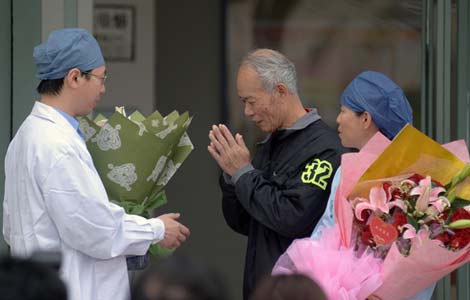Story of inspiration from a group once shunned
Updated: 2013-01-30 09:24
By Yang Wanli (China Daily)
|
||||||||
Leprosy patients show the spirit of life, reports Yang Wanli in Dongguan, Guangdong province
Approximately 26 kilometers off the coast of Taishan city in Guangdong province lies a small island called Daqin. Although famous for its natural beauty, the island is not a summer resort, nor a haven of peace and happiness complete with fishermen and folk songs.
Hidden from the eyes of the world, the island was once regarded as a hellish place by local people who said it was populated by "monsters" lacking fingers, toes and sometimes even entire limbs. Children were scared into good behavior by tales of ugly, distorted faces.
But the inhabitants of Daqin were not monsters: They were Mafeng Lao - a local name for those with leprosy.
For almost a century, Daqin was the largest of Guangdong's 100-plus leper colonies. Established in 1924 to isolate the sick from other residents, the island was home to almost 2,000 patients at its peak. By 2011, when the facility was closed, the number of residents had dwindled to 44 with an average age of 75. Some were blind and bedridden. Others had seen their bodies ravaged by the consequences of disease.
Wu Yunqi is one of the Mafeng Lao. He lived on Daqin for nearly 60 years. Although his first symptoms appeared at 13, Wu's condition wasn't fully diagnosed until 18 years later. He was quickly sent to the island and never saw his family again.
The island had no running water, no electricity, no TV and sometimes, during the typhoon season, no food other than salted vegetables.
Until 1998, when the local government donated a speed boat to the community, the residents' only connection with the outside world was a small wooden sailboat that visited once or twice a week. Life was counted out by the day.
For the past half century, 90-year-old Wu has prayed every day for spiritual support to help him cope with a condition that results in atrophy of the nerve endings. The loss of sensitivity leaves patients vulnerable to cuts and grazes that go unnoticed. The lacerations then become infected. Wu's left leg is crippled and bears many terrible scars. He has one enduring hope - that he will see his two children again.
In 2011, the island's last patients were transferred to Si'an island, close to Dongguan city, famous for its manufacturing base. The move was a government project to improve living conditions for the sufferers. Si'an island, a mere five-minute boat ride to the shore, is far more accessible than Daqin, which took at least an hour to reach.
Wu believed that moving closer to the shore has improved his chances of seeing his family again. However, the reality is that his life will end without reconciliation.
Late last year, Wu's story was taken up by the local media and eventually his son and daughter, both in their 60s, came forward. However, they refused to visit the island and see their father. The only image Wu has of his children is a photograph of them with their grandmother. The children will have changed, though, as his son sent it in the 1970s.
Related:

 Li Na on Time cover, makes influential 100 list
Li Na on Time cover, makes influential 100 list
 FBI releases photos of 2 Boston bombings suspects
FBI releases photos of 2 Boston bombings suspects
 World's wackiest hairstyles
World's wackiest hairstyles
 Sandstorms strike Northwest China
Sandstorms strike Northwest China
 Never-seen photos of Madonna on display
Never-seen photos of Madonna on display
 H7N9 outbreak linked to waterfowl migration
H7N9 outbreak linked to waterfowl migration
 Dozens feared dead in Texas plant blast
Dozens feared dead in Texas plant blast
 Venezuelan court rules out manual votes counting
Venezuelan court rules out manual votes counting
Most Viewed
Editor's Picks

|

|

|

|

|

|
Today's Top News
Boston bombing suspect reported cornered on boat
7.0-magnitude quake hits Sichuan
Cross-talk artist helps to spread the word
'Green' awareness levels drop in Beijing
Palace Museum spruces up
First couple on Time's list of most influential
H7N9 flu transmission studied
Trading channels 'need to broaden'
US Weekly

|

|







